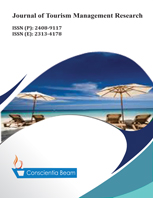Integrating priori and posteriori approaches to segment types of food tourists: Food tourist segmentation
DOI:
https://doi.org/10.18488/31.v12i1.4160Abstract
The purpose of this study employs both a priori and posteriori approaches to classify food tourists based on their daily food exploration behaviors and investigates the differences between their daily dining behaviors and travel dining behaviors. Data were collected from 744 tourists who visited four Hakka traditional cultural areas online. The cluster analysis results indicate that tourists can be divided into two groups: those who love diverse food and those who prefer familiar food. The t-test results indicated that those who love diverse food place more importance on maintaining a balanced daily diet than those who prefer familiar food. Those who love diverse food and are more willing to try various new and novel foods would avoid the potential risks of trying new foods while traveling, refrain from indulging in random food, and pay attention to preparing health products when traveling. However, there was no difference between the two types of tourists in choosing familiar foods or cooking methods while traveling. Culinary tourism requires service design to align with tourist values. Promoting Hakka cuisine through marketing and modern health-conscious practices can enhance its appeal. Encouraging sustainable culinary experiences helps preserve traditions while addressing industry challenges in adapting to change.

